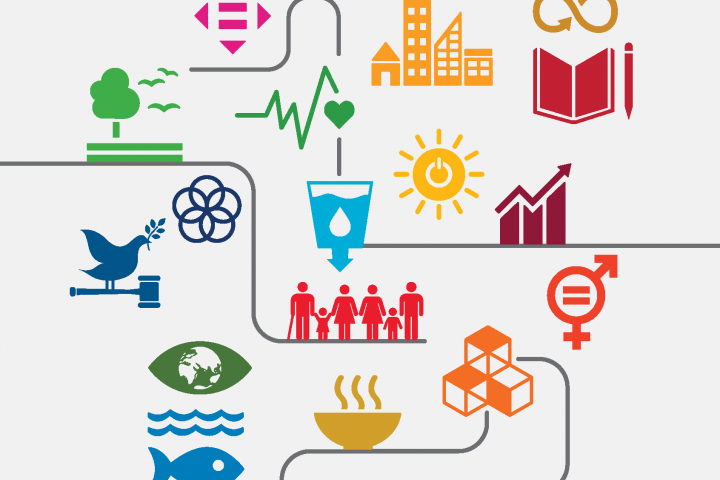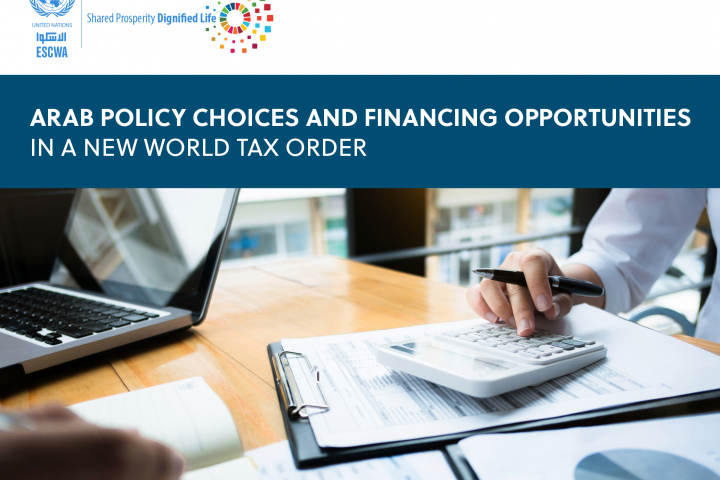Press release
10 Nov 2016
ESCWA Launches Survey of Economic and Social Developments in the Arab Region 2015-2016
From its headquarters in Riad el Solh, Beirut, ESCWA launched this morning its annual report on Economic and Social Developments in the Arab Region, 2015-2016. This year’s report placed focus on a five-year review of the effects of recent political changes on the countries of the region, and a review of gender equality and the status of Arab women.
The press briefing gathered a crowd of local, regional and international media representatives, and kicked off with a presentation by Director of ESCWA Economic Development and Integration Division Mohamed el Moctar Mohamed el Hacene, who tackled the trend of economic and social development in the global as well as regional context. The assessment shows that the economic and political uncertainty continues to restrain the region’s prospects for growth, job creation and stability. Economic expansion remains stalled, with persistently low global oil prices adding a further burden to the regional economy and constraining the growth and fiscal balances of those countries that had been top performers due to energy exports. Estimates have placed the average growth rate of gross domestic product (GDP) in the Arab region in real terms at 0.9 per cent in 2015, unchanged from 2014. GDP in the region is forecast to grow by 1.5 per cent in 2016. Economic expansion in GCC countries is projected to continue decelerating, as further cuts to public expenditure are expected. The anticipated monetary tightening by the United States and an increase in debt issuance by GCC Governments are likely to discourage investment. Other Arab subregions will also experience weak growth due to geopolitical factors, the prospect of weak demand from China and Europe and tightening balance-of-payments conditions.
Conflicts, Syria and Lebanon
Chief of ESCWA Modeling and Forecasting Section (MFS) Mohamed Hedi Bchir then noted that 5 years after the initial political change, severe economic and social turbulence remains across the Arab region. Some transitions devolved into conflicts, also affecting neighbouring-countries, and together, direct and indirect effects of transition have led to net $614 billion Gross Domestic Product (GDP) loss. There could be long-lasting effects in these areas and also on institutions and governance.
The number of refugees globally topped 60 million by end-2015, which is more than any point since WWII, said Hedi Bchir. On the regional level, there are 7.6 million Syrians displaced internally, and over 4 million externally, while in Yemen, there are 130,000 internally displaced, with several who fled abroad as well. By end of 2015, the number of internally displaced persons in Libya reached 434,000. On this note, Europe has seen an increase of 74.3% in refugee inflows, while Turkey is the largest refugee host (1.6 million Syrian refugees by end-2014), and Lebanon hosts most refugees per capita (25%). The region knows persistent unemployment, particularly among women and the young, which leads to the type of frustration and unrest that was seen in 2011.
On the Case of Syria, Hedi Bchir said the conflict led to 470,000 deaths, and a population decrease by one-fifth. He noted total losses of $259 billion; $169 billion of foregone output and $89 billion of physical capital loss. The loss is three times the size of 2010 GDP, he said. As for public consumption, it has fallen by 1/3 fall from 2014-15, with a fall in investment, rising inflation, and debt. 49% of capital stock was lost due to damaged capital stock, 34% due to lost net investment and 17% to idle capital stock. Unemployment rose from 15% in 2011 to 48% in 2014. Hedi Bchir said that in 2014, over 80% of the Syrian population lived below the poverty line, concentrated in areas of extreme fighting.
On Lebanon, he said that the number of Syrian refugees living in the country amounts to 1.5 million people, accounting for roughly the quarter of the total Lebanese population. Most of the refugees live in rural and poor areas. It has been estimated that the dense influx, could double unemployment to 20%, pushing 170,000 Lebanese into poverty. Recent estimates suggest that the number of vulnerable Lebanese matches that of Syrian refugees (1.5 million). Including 300,000 Palestinian refugees and 42,000 Palestinian refugees displaced from their Syrian homes, that means more than 3.3 million people in need. Further, 52% of displaced Syrians and 10% of Lebanese are classified as “extremely poor” (earning less than $2.40/day). Demand for utilities and government services has risen, with an estimated $1.1 billion added expenditure on them to respond to the needs of refugees, which leads to a budget deficit of $2.6 billion between 2012 and 2014 alone.
Associate Economic Affairs Officer at MFS Nathalie Khaled then presented the report’s findings on gender equality. She noted that women in the Arab region still suffer from inequality at all levels. However, concerning political representation, 17.5% of parliamentarians in the region are women, compared with 14% average last year, with Algeria, Tunisia and Sudan leading on this front. The enforcement of the quota system remains the most recommended measure to increase women’s participation and representation in decision making. Women participation in the labour market remains low with an average of 23.4% compared with 75% participation rate for males in 2014. Unemployment is high for men and women, but the gender gap is also wide. The Arab region will need to do more to foster more and quality jobs for women and improve social protection systems and labour laws. Domestic work, mostly involving women migrants, accounts for 5.6% of total employment in the region. Some Arab States have enacted laws to protect domestic workers, but enforcement and monitoring mechanisms are needed.



